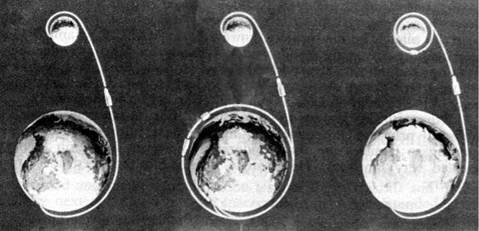Sub-orbital flights
The first rockets to fly into space flew simple “up and down” ballistic flights to high altitude, but did not reach the velocity or height to enter Earth orbit. Many were used for science missions in the upper atmosphere (starting in the 1940s) and often carried animals. The payloads were usually, but not always, recovered. These trajectories gave engineers the opportunity to put their equipment though the stresses of launch, reentry and recovery without committing it to orbital flight. The first two Americans in space in 1961 flew this type of trajectory, although the Russians abandoned their suborbital programme in order to place the first person in orbit ahead of the Americans.
Flight paths
In order to save fuel and weight, the rotation of the Earth is used to give any launch a speed boost. Therefore, most launch sites are situated on or as close as possible to the equator to take maximum advantage of this and launch their spacecraft into a west-to – east trajectory. An east-to-west launch is possible, but it would be very expensive in terms of launch weight and fuel, and therefore cost. A rocket reaching a speed of approximately 29,000 kph (18,000 mph) can overcome the effects of Earth’s gravity pulling it back to the ground and enter an arc around the planet, known as an orbit. Strictly speaking of course, an orbiting spacecraft is still falling towards the Earth – it’s just travelling fast enough to keep missing it. There are many types of orbits, and all crewed flights to date have entered relatively low altitude Earth orbit, even if they have later further boosted their speed in order to head out into deeper space. An orbit has a high and low point, known respectively as the apogee and perigee, and an orbit with a very high apogee is known as a highly elliptical orbit.
Satellites are launched into different inclinations, or angles to the equator. A polar orbit flies approximately over the north and south poles, effectively at almost a 90- degree inclination. Most orbits feature inclinations that are much lower than this. Geostationary, or geosynchronous, orbiting satellites orbit around the equator at approximately 35,000 km (22,000 miles) and travel at the same speed as the Earth rotates, giving the perception of being “stationary” in the sky as seen by an observer. Such orbits are mainly used by communications and weather satellites. All crewed vehicles have so far been placed in relatively low-altitude and low-inclination Earth orbits, although there was a proposal to fly an Apollo mission into a highly elliptical Earth orbit and plans for polar-orbiting Shuttle missions were abandoned in 1986.
|
An illustration of the options that Apollo could use to reach the Moon: (left) Direct Ascent; (centre) Earth Orbital Rendezvous, or EOR; (right) Lunar Orbital Rendezvous, or LOR – the method eventually chosen. |
The Apollo lunar flights (1968-1972) used low-Earth parking orbits before heading out towards the Moon, using an additional engine burn of the upper stage to begin their trans-lunar trajectory. Once at the Moon, the spacecraft could either fly once around the Moon and back to the Earth (called a circumlunar trajectory – this was used for Soviet unmanned Zond missions which were precursors of planned but unflown manned missions), or orbit the Moon or land on it. The original flight plans for US manned lunar landings included several options: A direct ascent to the Moon surface using a powerful booster, joining two craft together in Earth orbit before flying out to the Moon, or a lunar orbit rendezvous (which was the method chosen for Apollo) with the Command Service Module (CSM) and two-stage Lunar Module (LM) flying together on one booster. After the Moon landing expedition was over, the ascent stage of the LM rendezvoused with the CSM in lunar orbit, the crew transferred between vehicles and the CSM headed home for parachute landing in the ocean. The new plans for the return to the Moon resemble aspects of the Earth Orbital Rendezvous method that was considered for Apollo.











